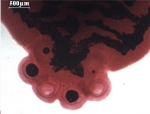NEIHPID
North-East India Helminth Parasite Information Database
Recently added
Parasites
Molecular Data
Polystoma indicum (Diengdoh et Tandon Diengdoh et Tandon)
Taxonomy
Platyhelminthes »
MONOGENEA »
Polystomatoidea Price, 1936 »
Polystomatidae Gamble, 1896 »
Polystomatinae Gamble, 1896 »
Polystoma Zeder, 1800 »
Polystoma indicum, Diengdoh et Tandon 1991
Host
Hyla (annectans), Polypedates (leucomystax), Rhacophorus (bipunctatus(=R. reinwardtii)), Rhacophorus ( maximus (=R. nigropalmatus))
Habitat
Urinary bladder, Ureter, Body cavity
Locality
Shillong (Meghalaya), Cherrapunjee (Meghalaya), Mawsynram (Meghalaya), Kohima (Nagaland), Mokokchung (Nagaland), Zunheboto (Nagaland)
Description
Body elongate, foliate, somewhat tapering towards anterior end, 6.73-16.65 mm in length, 2.22-5.64 mm in maximum width across middle-third length. Prohaptor a sub-terminal oral sucker encircling mouth. Opisthaptor small compared to body dimensions, usually less than half in breadth compared to maximum breadth of soma, with three pairs of well developed suckers and a pair of macrohooks or hamuli; latter variable in shape and size, with base entire and smooth or with slight or deep incision, and sharply pointed recurved tips; microhooks 16 in number, 1 in each clamp, 2 pairs below hamuli, 3 pairs in anterior region of opisthaptoral disc. Pharynx prominent, muscular, leading to bifurcate intestine. Intestinal caeca indented at irregular intervals on lateral aspects, sending out 10-15 prominent diverticula from their inner facet, which in turn give off secondary branches, interspersed with 6-10 smaller unbranched diverticula; caeca usually united in immediate pre-haptoral region, may extend into opisthaptoral disc; diverticula also randomly anastomosing medially, number of pre-haptoral anastomoses 1-2 in most specimens, often more, diverticulation almost absent in region of caecal union. Testes numerous, forming insurmountable mass in post-ovarian intercaecal zone, commencing just behind vitello-vaginal ducts; vas deferens arising in region of junction of female genital ducts,running anteriad slightly to side of median line;cirrus sac small, cirrus tipped with genital crown of 8 hooklets, opening in front of female genital pore into common genital sinus, latter opening to exterior close behind intestinal bifurcation. Ovary retort shaped, on left or right of median line; Mehlis' gland complex opposite to base of ovary; uterus emerging from junction of oviduct to vitelline reservoir, proceeding anteriad in serpentine course, containing numerous eggs (up to 40); genito-intestinal canal given off from same junction as uterus, opening into caecum of ovarian side. Vaginae on either lateral margin of body between genital pore and ovary. Eggs 0.19-0.214 x 0.125-0.140 mm. Vitellaria follicular, extensive, commencing from pharyngeal level, posteriorly extending into opisthaptoral zone and intruding in spaces between suckers, overlapping intestinal diverticula, confined only to lateral sides (though still overlapping caeca) in ovarian and uterine regions.
Specimens collected from hosts from Nagaland, smaller in size, 3.1-3.81 X 1.39-1.81 mm.
Hamuli with entire base. Opisthaptor considerably small compared to body dimensions. Intestinal anastomoses few and random, not reticulate. Eggs numerous in uterus in egg-producing stage.
Remarks
As the first representative of the genus Polystoma from the Indian subcontinent, P. indicum was originally described from Rhacophorus nigropalmatus from Cherrapunjee (Meghalaya) by Diengdoh and Tandon (1991) and has also been reported from Rhacophorus reinwardtii from Shillong and Mawsynram (Dutta,1995).The flukes recovered from Hyla annectans exhibited some differences from those recovered from R. reinwardtii and P. leucomystax in respect of their surface fine topographical details; the tegumental papillae were not conspicuous in the former.
Helminthological collections record
NEHU/Z -MA/7.1 -7.10 Polystoma indicum (Meghalaya); MA/1.1 -1.5 Polystoma indicum
Specimen Type
Holotype: IV/ERS 304; 305 (2 Paratypes) in Zoological Survey of India (Eastern Regional Station) Shi
References
Diengdoh, C.R. and Tandon, V. (1991) A New species of Polystoma (Monogenea) Parasites in rhacophorid amphibians in Meghalaya , India. Helminthogia. 28:pp 173-178.
Dutta, M. (1995) Studies on the Monogenean and Cestode Parasites of Anuran Amphibian Hosts in Meghalaya, India. Morphological, Ecological and Biological aspects. Ph.D. thesis. North Eastern Hill University (N.E.H.U). Shillong. pp 98.




